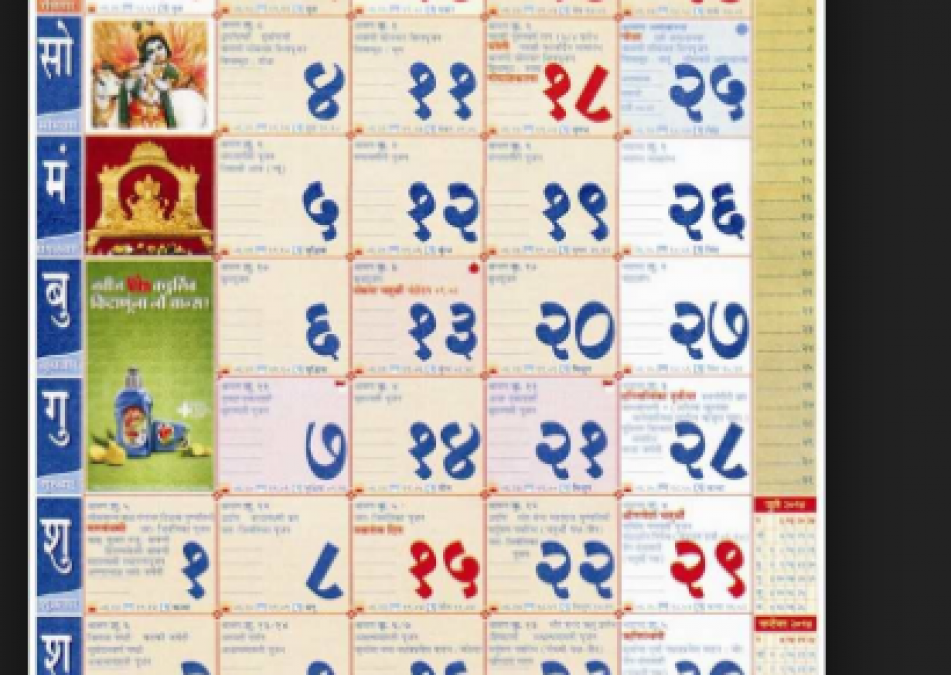
Like the Gregorian calendar used by most western nations, the Indian calendar is based on days measured by the movement of the sun, and weeks measured in seven-day increments. At this point, however, the means of time-keeping changes. While in the Gregorian calendar, the individual months vary in length to accommodate the difference between the lunar cycle and the solar cycle, with a "leap day" inserted every four years to ensure that a year is 12 months long, in the Indian calendar, each month consists of two lunar fortnights, beginning with a new moon and containing exactly two lunar cycles. To reconcile the differences between the solar and lunar calendars, an entire extra month is inserted about every 30 months. Because holidays and festivals are carefully coordinated with lunar events, this means that dates for important Hindu festivals and celebrations may vary from year to year when viewed from the Gregorian calendar. It also means that each Hindu month has a different starting date than the corresponding month in the Gregorian calendar. A Hindu month always starts on the day of the new moon.
The Hindu Days
Names of the seven days in the Hindu week:
Raviãra: Sunday (day of Sun)
Somavãra: Monday (day of Moon)
Mañgalvã: Tuesday (day of Mars)
Budhavãra: Wednesday (day of Mercury)
Guruvãra: Thursday (day of Jupiter)
Sukravãra: Friday (day of Venus)
Sanivãra: Saturday (day of Saturn)
also read Buddhism and Compassion: Teaching and lessons to live life peacefully
The Hindu Months: Names of the 12 months of the Indian Civil Calendar and their correlation with the Gregorian calendar:
Chaitra (30/ 31* Days) Begins March 22/ 21*
Vaisakha (31 Days) Begins April 21
Jyaistha (31 Days) Begins May 22
Asadha (31 Days) Begins June 22
Shravana (31 Days) Begins July 23
Bhadra (31 Days) Begins August 23
Asvina (30 Days) Begins September 23
Kartika (30 Days) Begins October 23
Agrahayana (30 Days) Begins November 22
Pausa (30 Days) Begins December 22
Magha (30 Days) Begins January 21
Phalguna (30 Days) Begins February 20
* Leap years
Hindu Eras and Epochs: Westerners used to the Gregorian calendar quickly notice that the year is dated differently in the Hindu calendar. Western Christians, for example, all mark the birth of Jesus Christ as year zero, and any year before that is denoted as BCE (before Common Era), while the years following are denoted CE. The year 2017 in the Gregorian calendar is therefore 2,017 years after the assumed date of Jesus' birth. Hindu tradition marks large spaces of time by a series of Yugas (roughly translated as "epoch" or "era" that fall in four-era cycles. The complete cycle consists of the Satya Yuga, the Treta Yuga, the Dvapara Yuga and the Kali Yuga. By the Hindu calendar, our present time is the Kali Yuga, which began in the year corresponding to the Gregorian year 3102 BCE, when the Kurukshetra war is thought to have ended. Therefore, the year labeled 2017 CE by the Gregorian calendar is known as the year 5119 in the Hindu calendar.
Most modern Hindus, while familiar with a traditional regional calendar, are equally familiar with the official civil calendar, and many are quite comfortable with the Gregorian calendar, as well.
also read Vedic Hindu deities’ symbols and the forces of nature inside a human being